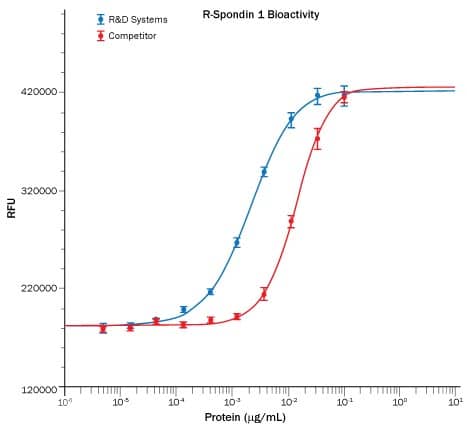Human/Mouse RPTOR Antibody Summary
Lys77-Gln230
Accession # Q8N122
Customers also Viewed
Applications
Please Note: Optimal dilutions should be determined by each laboratory for each application. General Protocols are available in the Technical Information section on our website.
Scientific Data
 View Larger
View Larger
Detection of Human and Mouse RPTOR by Western Blot. Western blot shows lysates of 293T human embryonic kidney cell line, HeLa human cervical epithelial carcinoma cell line, and Neuro-2A mouse neuroblastoma cell line. PVDF Membrane was probed with 1 µg/mL of Human/Mouse RPTOR Monoclonal Antibody (Catalog # MAB5957) followed by HRP-conjugated Anti-Mouse IgG Secondary Antibody (Catalog # HAF007). A specific band was detected for RPTOR at approximately 150 kDa (as indicated). This experiment was conducted under non-reducing conditions and using Immunoblot Buffer Group 1.
 View Larger
View Larger
Detection of RPTOR in HeLa Human Cell Line by Flow Cytometry. HeLa human cervical epithelial carcinoma cell line was stained with Mouse Anti-Human/Mouse RPTOR Monoclonal Antibody (Catalog # MAB5957, filled histogram) or isotype control antibody (Catalog # MAB0041, open histogram), followed by Phycoerythrin-conjugated Anti-Mouse IgG Secondary Antibody (Catalog # F0102B). To facilitate intracellular staining, cells were fixed with Flow Cytometry Fixation Buffer (Catalog # FC004) and permeabilized with Flow Cytometry Permeabilization/Wash Buffer I (Catalog # FC005). View our protocol for Staining Intracellular Molecules.
 View Larger
View Larger
Detection of RPTOR in C2C12 Mouse Cell Line by Flow Cytometry. C2C12 mouse myoblast cell line was stained with Mouse Anti-Human/Mouse RPTOR Monoclonal Antibody (Catalog # MAB5957, filled histogram) or isotype control antibody (Catalog # MAB0041, open histogram), followed by Phycoerythrin-conjugated Anti-Mouse IgG Secondary Antibody (Catalog # F0102B). To facilitate intracellular staining, cells were fixed with Flow Cytometry Fixation Buffer (Catalog # FC004) and permeabilized with Flow Cytometry Permeabilization/Wash Buffer I (Catalog # FC005). View our protocol for Staining Intracellular Molecules.
Preparation and Storage
- 12 months from date of receipt, -20 to -70 °C as supplied.
- 1 month, 2 to 8 °C under sterile conditions after reconstitution.
- 6 months, -20 to -70 °C under sterile conditions after reconstitution.
Background: RPTOR
RPTOR (Raptor) is a 150 kDa component of the cytosolic mammalian target of Rapamycin complex 1 (mTORC1) which also contains mTOR and GBL proteins. mTORC1 plays a dominant role in cell cycle regulation in response to metabolic conditions. The interaction of RPTOR with the kinase mTOR is stabilized under conditions of nutrient deprivation and energy stress, leading to inhibition of mTOR and cell cycle arrest. RPTOR contains multiple Ser and Thr residues whose phosphorylation regulates the activation status of mTOR. RPTOR is critical for the response of skeletal muscle and adipose tissue to insulin. It contains three RNC blocks (aa 48-511), three HEAT repeats (aa 550-667), and seven C-terminal WD40 domains (aa 1020-1335). Within aa 77-230, human RPTOR shares 100% aa sequence identity with mouse and rat RPTOR.
Product Datasheets
FAQs
No product specific FAQs exist for this product, however you may
View all Antibody FAQsIsotype Controls
Reconstitution Buffers
Secondary Antibodies
Reviews for Human/Mouse RPTOR Antibody
There are currently no reviews for this product. Be the first to review Human/Mouse RPTOR Antibody and earn rewards!
Have you used Human/Mouse RPTOR Antibody?
Submit a review and receive an Amazon gift card.
$25/€18/£15/$25CAN/¥75 Yuan/¥2500 Yen for a review with an image
$10/€7/£6/$10 CAD/¥70 Yuan/¥1110 Yen for a review without an image















